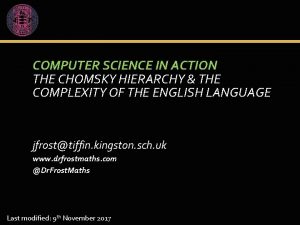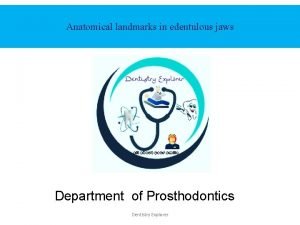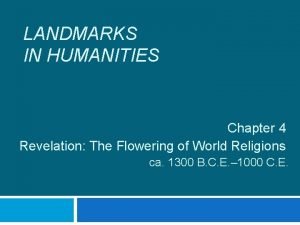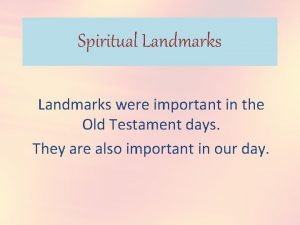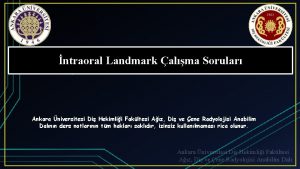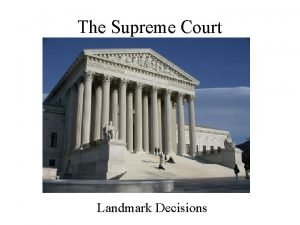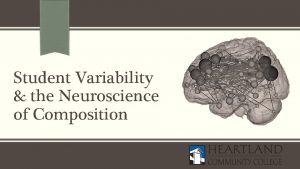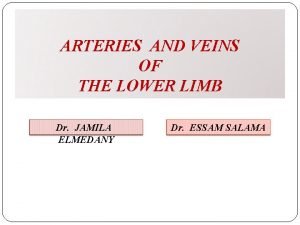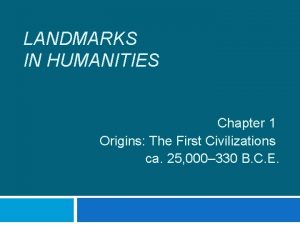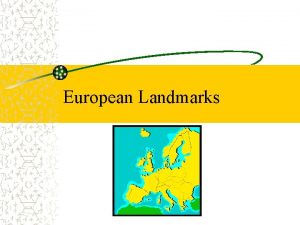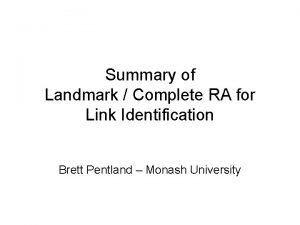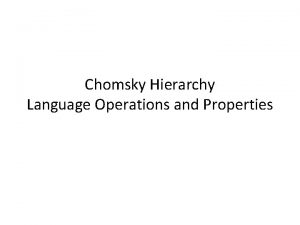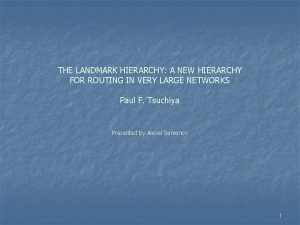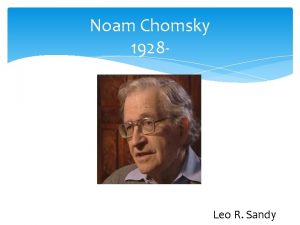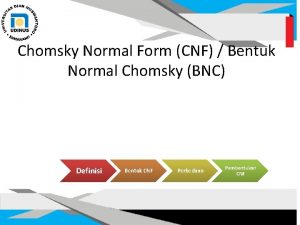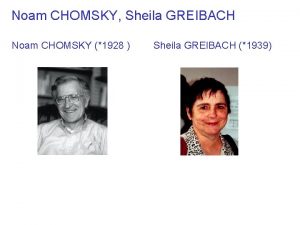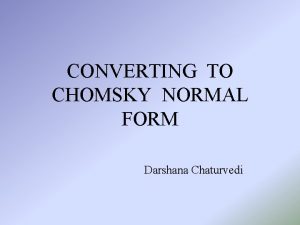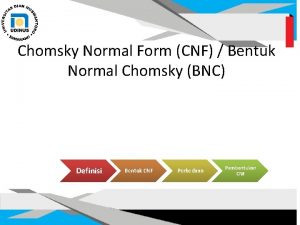Chomsky Hierarchy In his landmark paper Chomsky N














- Slides: 14

Chomsky Hierarchy • In his landmark paper (Chomsky, N. Three models for the description of language. IRE Transactions on Information Theory, 1956, IT-2, 113 -124) Chomsky described a hierarchy of • • different types of grammars. Type 3 grammars (regular) describe the smallest set of languages. Type 2 grammars (context-free) describe a larger set of languages that contains the regular languages. Type 1 grammars (context-sensitive) describe a still larger set of languages that contains the context-free languages. Type 0 grammars describe all computable languages. Lecture #7 PLP Spring 2004, UF CISE 1

Chomsky Hierarchy Diagram Type 0 (unrestricted) Type 1 (context-sensitive) Type 2 (context-free) Type 3 (regular) Lecture #7 PLP Spring 2004, UF CISE 2

Grammars • Each of Chomsky’s grammar types contains grammars of the following form: G = (V, T, P, S) where – – – G, a grammar is a 4 -tuple consisting of (V, T, P, S). V is a finite set of nonterminal symbols, T is a finite set of terminal symbols, P is a finite set of productions or rewriting rules. S V is the distinguished symbol or the start symbol. • For all grammar types, V, T, and S are identical. The form of the productions P varies. Lecture #7 PLP Spring 2004, UF CISE 3

Type 3 Grammars (The Regular Languages) • P contains rules of the following forms: A→a. B A→a where A, B V; a T ε. • Although I won’t do it here, one can prove that the set of languages generated by such a grammar is exactly the set of languages generated by regular expressions. (Hint: find a way to write a type 3 grammar rule for each of the base cases of the regular expressions, then figure out a way to write a grammar for each of the recursive rules). Lecture #7 PLP Spring 2004, UF CISE 4

How a Grammar Describes a Langauge • A grammar can be used to generate strings. The set of strings generated by a grammar is termed the language of the grammar. • A derivation starts with the start symbol S. • A sequence of terminals and nonterminals generated by a sequence of 0 or more derivation steps from the start symbol is termed a sentential form. • If A is a sentential form and A→ is a production, then A is a derivation step. • * is the transitive, reflexive closure of . That is, A * if there is a sequence of zero of more derivation steps, A 1 2 . . . , deriving from A. • A string X of terminal symbols is said to be in the language of grammar G (denoted LG) if S *X. Lecture #7 PLP Spring 2004, UF CISE 5

Generating a String • Consider the following grammar: – G = ({S}, {a, b}, {S→Sa, S→b}, S) • Let’s derive some strings using G. S Sa ba S Sa Saa baa Lecture #7 PLP Spring 2004, UF CISE 6

Type 2 Grammars (The Context-Free Languages) • P contains rules of the following form: A→ where (V T)* • Type 2 (or context-free) grammars are typically used to describe the gross-level syntax of computer languages. They have been used as rudimentary forms of grammars for natural languages as well. • The context-free adjective comes by way of comparison with the context-sensitive grammars. Lecture #7 PLP Spring 2004, UF CISE 7

Type 1 Grammars (The Context-Sensitive Languages) • P contains rules of the following form: A → where A V; , (V T)*, (V T)+ • Here, the context, or symbols surrounding a nonterminal can constrain the application of a rule. In a context-free language (CFL), the context of a nonterminal never determines whether or not a rule can be applied. • In addition, each rule must be nonreducing, that is, no string in a derivation can be shorter than the string from which it was derived. The special case of a language containing the empty string is handled by allowing the unique rule S→ε. Lecture #7 PLP Spring 2004, UF CISE 8

Type 0 languages • No restrictions are made on the form of the productions. Rules can reduce the length of a string. Terminal symbols can appear alone on the left hand side of a production. No restrictions whatsoever apply. Lecture #7 PLP Spring 2004, UF CISE 9

Association of Grammar Types to Machines • As you already know, regular (type 3) languages can be recognized by finite state machines, or deterministic finite automata (DFAs). • Context-free languages can be recognized by a finite state machine augmented to have a pushdown stack. Such a machine is known as a push-down automaton (PDA). • Context-sensitive languages can be recognized by a PDA with an extra stack. Such a machine is known as a 2 -PDA • Unrestricted languages can be recognized by a Turing machine. Lecture #7 PLP Spring 2004, UF CISE 10

Context-Free Grammars and Parse Trees • Consider a grammar with the following productions: – – – – – sentence → noun-phrase verb-phrase noun-phrase → article noun article → a article → the noun → girl noun → dog verb-phrase → verb noun-phrase verb → sees verb → pets • We can abbreviate multiple occurrences of a rule using a vertical bar for alternation: article→a | the noun→girl | dog Lecture #7 PLP Spring 2004, UF CISE 11

Derivations and Parse Trees sentence noun-phrase verb-phrase article noun verb-phrase a girl verb noun-phrase a girl sees noun-phrase sentence a girl sees article noun a girl sees the noun-phrase verb-phrase a girl sees the dog article noun verb noun-phrase a girl sees article the Lecture #7 PLP Spring 2004, UF CISE noun dog 12

Leftmost Derivations • The derivation used on the previous viewgraph was a leftmost derivation. That is, each derivation step rewrote the leftmost nonterminal symbol. Clearly, two strings having the same leftmost derivation have the same parse tree. • We could have generated the same parse tree using a different derivation, a rightmost derivation, for example. Lecture #7 PLP Spring 2004, UF CISE 13

Grammar Rules and Set Equations • One can think of a grammar rule as being a set equation. • Consider this rule: expr→expr + expr | number • Let E represent the set of strings generated by the nonterminal expr, and let N represent the set generated by number. • The equation E = E + E N holds (where + represents the language {+} • This definition is recursive, but E clearly contains N. • Likewise, if E contains N, then it must contain N + N. Similarly, it must contain N+N+N. • Carrying this to its logical conclusion, E = N N+N+N+N . . . = N (+N)*. Lecture #7 PLP Spring 2004, UF CISE 14
 Chomsky computer science
Chomsky computer science Chomsky language hierarchy
Chomsky language hierarchy Chomsky hierarchy of grammars
Chomsky hierarchy of grammars Denture anatomical landmarks
Denture anatomical landmarks What landmark legalized christianity?
What landmark legalized christianity? Ancient landmark definition
Ancient landmark definition Genial tüberküller
Genial tüberküller Miranda warning
Miranda warning What are the 5 heart sounds
What are the 5 heart sounds Brain parts
Brain parts Posterior tibial artery pulse
Posterior tibial artery pulse Landmark in humanities 5th edition
Landmark in humanities 5th edition Where is apical pulse taken
Where is apical pulse taken What is landmark
What is landmark Landmark option
Landmark option
